Temporal and Spatial Variation (2001–2020) Characteristics of Wind Speed in the Water Erosion Area of the Typical Black Soil Region, Northeast China
Abstract
1. Introduction
2. Materials and Methods
2.1. Study Area
2.2. Data Sources
2.3. Wind Speed Classification
2.4. Analysis Method
2.4.1. Cumulative Anomaly Method and Mann–Kendall Test Method
2.4.2. Kriging Interpolation Method
2.4.3. Geographic Detectors
2.4.4. Degree Classification of the Wind Impacts
3. Results and Discussion
3.1. Temporal Variation of Wind Speed
3.1.1. Interannual Variation
3.1.2. Seasonal Variation within the Year
3.2. Spatial Variation of Wind Speed
3.2.1. Spatial Variation Characteristics of Wind Speed
3.2.2. Spatial Variation of Wind Speed in April and May
3.2.3. Spatial Characteristics of Strong Wind Days
3.2.4. Influencing Factors on Spatial Heterogeneity of Wind Speed
3.3. Wind Impacts Degree
4. Conclusions
Author Contributions
Funding
Institutional Review Board Statement
Informed Consent Statement
Data Availability Statement
Acknowledgments
Conflicts of Interest
References
- Liu, X.; Lee Burras, C.; Kravchenko, Y.S.; Duran, A.; Huffman, T.; Morras, H.; Studdert, G.; Zhang, X.; Cruse, R.M.; Yuan, X. Overview of Mollisols in the world: Distribution, land use and management. Can. J. Soil. Sci. 2012, 92, 383–402. [Google Scholar] [CrossRef]
- Baveye, P.C.; Rangel, D.; Jacobson, A.R.; Laba, M.; Darnault, C.; Otten, W.; Radulovich, R.; Camargo, F.A.O. From Dust Bowl to Dust Bowl: Soils are Still Very Much a Frontier of Science. Soil Sci. Soc. Am. J. 2011, 75, 2037–2048. [Google Scholar] [CrossRef]
- Cleveland, C.J. Resource degradation, technical change, and the productivity of energy use in U.S. agriculture. Ecol. Econ. 1985, 13, 185–201. [Google Scholar] [CrossRef]
- De Alba, S.; Lindstrom, M.; Schumacher, T.E.; Malo, D.D. Soil landscape evolution due to soil redistribution by tillage: A new conceptual model of soil catena evolution in agricultural landscapes. Catena 2004, 58, 77–100. [Google Scholar] [CrossRef]
- Stout, J.E.; Lee, J.A. Indirect evidence of wind erosion trends on the Southern High Plains of North America. J. Arid. Environ. 2003, 55, 43–61. [Google Scholar] [CrossRef]
- Stout, J.E. A field study of wind erosion following a grass fire on the Llano Estacado of North America. J. Arid. Environ. 2012, 82, 165–174. [Google Scholar] [CrossRef][Green Version]
- Kucher, A.; Kazakova, I.; Kucher, L.; Schraml, A.; Koka, H.; Priest, W. Sustainable use of land in danger of wind erosion in Ukraine: Stakeholder engagement. Agric. Resour. Econ. Int. Sci. E-J. 2015, 1, 5–28. Available online: https://www.are-journal.com/are/article/view/15 (accessed on 4 August 2022).
- Zhang, G.; Yang, Y.; Liu, Y. Advances and Prospects of Soil Erosion Research in the Black Soil Region of Northeast China. J. Soil Water Conserv. 2022, 36, 1–12. [Google Scholar] [CrossRef]
- Liu, B.; Zhang, G.; Xie, Y. Delineating the black soil region and typical black soil region of northeastern China. Chin. Sci. Bull. 2021, 66, 96–106. [Google Scholar] [CrossRef]
- Fang, H. Effect of soil conservation measures and slope on runoff, soil, TN, and TP losses from cultivated lands in northern China. Ecol. Indic. 2021, 126, 107677. [Google Scholar] [CrossRef]
- Lin, H.; Xie, Y.; Liu, G.; Zhai, J.; Li, S. Soybean and maize simulation under different degrees of soil erosion. Field Crop. Res. 2019, 230, 1–10. [Google Scholar] [CrossRef]
- Liu, L.; Zhang, K.; Zhang, Z.; Qiu, Q. Identifying soil redistribution patterns by magnetic susceptibility on the black soil farmland in Northeast China. Catena 2015, 129, 103–111. [Google Scholar] [CrossRef]
- Zhou, K.; Sui, Y.; Liu, X.; Zhang, X.; Jin, J.; Wang, G.; Herbert, S.J. Crop rotation with nine-year continuous cattle manure addition restores farmland productivity of artificially eroded Mollisols in Northeast China. Field Crop. Res. 2015, 171, 138–145. [Google Scholar] [CrossRef]
- Ye, Y.; Fang, X.; Ren, Y.; Zhang, X.; Chen, L. Cropland cover change in Northeast China during the past 300 years. Sci. China Ser. D-Earth Sci. 2009, 52, 1172–1182. [Google Scholar] [CrossRef]
- Gu, Z.; Xie, Y.; Gao, Y.; Ren, X.; Cheng, C.; Wang, S. Quantitative assessment of soil productivity and predicted impacts of water erosion in the black soil region of northeastern China. Sci. Total Environ. 2018, 637–638, 706–716. [Google Scholar] [CrossRef]
- Fang, H.; Fan, Z. Assessment of Soil Erosion at Multiple Spatial Scales Following Land Use Changes in 1980–2017 in the Black Soil Region, (NE) China. IJERPH 2020, 17, 7378. [Google Scholar] [CrossRef]
- Shen, H.; He, Y.; Hu, W.; Geng, S.; Han, X.; Zhao, Z.; Li, H. The temporal evolution of soil erosion for corn and fallow hillslopes in the typical Mollisol region of Northeast China. Soil Tillage Res. 2019, 186, 200–205. [Google Scholar] [CrossRef]
- Xu, Y.; Qiao, J.; Pan, S.; Hou, X.; Roos, P.; Cao, L. Plutonium as a tracer for soil erosion assessment in northeast China. Sci. Total Environ. 2015, 511, 176–185. [Google Scholar] [CrossRef]
- Zhang, X.; Sui, Y.; Zhang, X.; Meng, K.; Herbert, S. Spatial Variability of Nutrient Properties in Black Soil of Northeast China. Pedosphere 2007, 17, 19–29. [Google Scholar] [CrossRef]
- Xu, X.; Xu, Y.; Chen, S.; Xu, S.; Zhang, H. Soil loss and conservation in the black soil region of Northeast China: A retrospective study. Environ. Sci. Policy. 2010, 13, 793–800. [Google Scholar] [CrossRef]
- Li, H.; Zhu, H.; Qiu, L.; Wei, X.; Liu, B.; Shao, M. Response of soil OC, N and P to land-use change and erosion in the black soil region of the Northeast China. Agric. Ecosyst. Environ. 2020, 302, 107081. [Google Scholar] [CrossRef]
- Du, Z.; Gao, B.; Ou, C.; Du, Z.; Yang, J.; Batsaikhan, B.; Dorjgotov, B.; Yun, W.; Zhu, D. A Quantitative Analysis of Factors Influencing Organic Matter Concentration in the Topsoil of Black Soil in Northeast China Based on Spatial Heterogeneous Patterns. IJGI 2021, 10, 348. [Google Scholar] [CrossRef]
- Duan, X.; Xie, Y.; Ou, T.; Lu, H. Effects of soil erosion on long-term soil productivity in the black soil region of northeastern China. Catena 2011, 87, 268–275. [Google Scholar] [CrossRef]
- Wang, Z.; Liu, B.; Wang, X.; Gao, X.; Liu, G. Erosion effect on the productivity of black soil in Northeast China. Sci. China Ser. D-Earth Sci. 2009, 52, 1005–1102. [Google Scholar] [CrossRef]
- Fang, H.; Sun, L. Modelling soil erosion and its response to the soil conservation measures in the black soil catchment, Northeastern China. Soil Tillage Res. 2017, 165, 23–33. [Google Scholar] [CrossRef]
- Zheng, H.; Liu, W.; Zheng, J.; Luo, Y.; Li, R.; Wang, H.; Qi, H. Effect of long-term tillage on soil aggregates and aggregate-associated carbon in black soil of Northeast China. PLoS ONE 2018, 13, e0199523. [Google Scholar] [CrossRef] [PubMed]
- Zhang, X.; Zhou, Q.; Chen, W.; Wang, Y.; Tong, D.Q. Observation and modeling of black soil wind-blown erosion from cropland in Northeastern China. Aeolian Res. 2015, 19, 153–162. [Google Scholar] [CrossRef]
- Zheng, F.; Zhang, J.; Liu, G. Characteristics of Soil Erosion on Sloping Farmlands and Key Fields for Studying Compound Soil Erosion Caused by Multi-forces in Mollisol Region of Northeast China. Bull. Soil Water Conserv. 2019, 39, 314–319. [Google Scholar] [CrossRef]
- Zuo, X.; Zheng, F.; Zhang, J. Study on Effect of Surface Wind Erosion on Hillslope Water Erosion in Regions of Typical Thin Layered Mollisol at Early Stages. Acta Pedol. Sin. 2021, 58, 1145–1156. [Google Scholar] [CrossRef]
- Liu, Y.; Yuan, F.; Wang, A.; Wu, J.; Zheng, X.; Yin, H.; Guan, D. Characteristics of climate change in Changbai Mountain ecological functional area, Northeast China. J. Appl. Ecol. 2019, 30, 1503–1512. [Google Scholar] [CrossRef]
- Wu, J.; Shi, Y.; Xu, Y. Evaluation and Projection of Surface Wind Speed Over China Based on CMIP6 GCMs. J. Geophys. Res.-Atmos. 2020, 125, e2020JD033611. [Google Scholar] [CrossRef]
- Rehman, S. Long-Term Wind Speed Analysis and Detection of its Trends Using Mann-Kendall Test and Linear Regression Method. Arab. J. Sci. Eng. 2013, 38, 421–437. [Google Scholar] [CrossRef]
- Kousari, M.R.; Ahani, H.; Hakimelahi, H. An investigation of near surface wind speed trends in arid and semiarid regions of Iran. Theor. Appl. Climatol. 2013, 114, 153–168. [Google Scholar] [CrossRef]
- Kohler, M.; Metzger, J.; Kalthoff, N. Trends in temperature and wind speed from 40 years of observations at a 200-m high meteorological tower in Southwest Germany. Int. J. Climatol. 2018, 38, 23–34. [Google Scholar] [CrossRef]
- Cellura, M.; Cirrincione, G.; Marvuglia, A.; Miraoui, A. Wind speed spatial estimation for energy planning in Sicily: A neural kriging application. Renew. Energy 2008, 33, 1251–1266. [Google Scholar] [CrossRef]
- Kleijnen, J.P.C. Kriging metamodeling in simulation: A review. Eur. J. Oper. Res. 2009, 192, 707–716. [Google Scholar] [CrossRef]
- Liu, H.; Shi, J.; Erdem, E. Prediction of wind speed time series using modified Taylor Kriging method. Energy 2010, 35, 4870–4879. [Google Scholar] [CrossRef]
- Fan, F.; Bell, K.; Hill, D.; Infield, D. Wind forecasting using kriging and vector auto-regressive models for dynamic line rating studies. In Proceedings of the 2015 IEEE Eindhoven PowerTech. IEEE, Eindhoven, The Netherlands, 29 June–2 July 2015; pp. 1–6. [Google Scholar] [CrossRef]
- Lee, C. Long-term wind speed interpolation using anisotropic regression kriging with regional heterogeneous terrain and solar insolation in the United States. Energy Rep. 2022, 8, 12–23. [Google Scholar] [CrossRef]
- Wang, J.; Zhang, T.; Fu, B. A measure of spatial stratified heterogeneity. Ecol. Indic. 2016, 67, 250–256. [Google Scholar] [CrossRef]
- Chen, J.; Yang, S.; Li, H.; Zhang, B.; Lv, J. Research on Geographical Environment Unit Division Based on the Method of Natural Breaks (Jenks). Int. Arch. Photogramm. Remote Sens. Spat. Inf. Sci. 2013, 3, 47–50. [Google Scholar] [CrossRef]
- Fariza, A.; Abhimata, N.P.; Nur Hasim, J.A. Earthquake disaster risk map in east Java, Indonesia, using analytical hierarchy process—Natural break classification. In Proceedings of the 2016 International Conference on Knowledge Creation and Intelligent Computing (KCIC), IEEE, Manado, Indonesia, 15–17 November 2016; pp. 141–147. [Google Scholar] [CrossRef]
- Fariza, A.; Rusydi, I.; Hasim, J.A.N.; Basofi, A. Spatial flood risk mapping in east Java, Indonesia, using analytic hierarchy process-natural breaks classification. In Proceedings of the 2017 2nd International Conferences on Information Technology, Information Systems and Electrical Engineering (ICITISEE), IEEE, Yogyakarta, Indonesia, 1–2 November 2017; pp. 406–411. [Google Scholar] [CrossRef]
- Xu, M.; Chang, C.-P.; Fu, C.; Qi, Y.; Robock, A.; Robinson, D.; Zhang, H. Steady decline of east Asian monsoon winds, 1969–2000: Evidence from direct ground measurements of wind speed. J. Geophys. Res. 2006, 111, D24111. [Google Scholar] [CrossRef]
- Chen, S.; Guo, J.; Song, L.; Li, J.; Liu, L.; Cohen, J. Inter-annual variation of the Spring haze pollution over the North China Plain: Roles of atmospheric circulation and sea surface temperature. Int. J. Climatol. 2019, 39, 783–798. [Google Scholar] [CrossRef]
- Han, L.; Wang, J.; Wang, G.; Wang, Z.; Wu, M. Spatial and temporal characteristics of average wind speed in the wind erosion region of northern China. J. Arid Land. 2018, 41, 963–971. [Google Scholar] [CrossRef]
- Guo, H.; Xu, M.; Hu, Q. Changes in near-surface wind speed in China: 1969–2005. Int. J. Climatol. 2011, 31, 349–358. [Google Scholar] [CrossRef]
- Zhang, R.; Zhang, S.; Luo, J.; Han, Y.; Zhang, J. Analysis of near-surface wind speed change in China during 1958–2015. Theor. Appl. Climatol. 2019, 137, 2785–2801. [Google Scholar] [CrossRef]
- Wagner, L.E. A history of Wind Erosion Prediction Models in the United States Department of Agriculture: The Wind Erosion Prediction System (WEPS). Aeolian Res. 2013, 10, 9–24. [Google Scholar] [CrossRef]
- Wang, Y.; Shao, M. Spatial variability of soil physical properties in a region of the loess plateau of pr China subject to wind and water erosion: Spatial Variability of Soil Physical Properties. Land Degrad. Develop. 2013, 24, 296–304. [Google Scholar] [CrossRef]
- Colazo, J.C.; Buschiazzo, D. The Impact of Agriculture on Soil Texture Due to Wind Erosion. Land Degrad. Dev. 2015, 26, 62–70. [Google Scholar] [CrossRef]
- Tuo, D.; Xu, M.; Zheng, S. Sediment-yielding process and its mechanisms of slope erosion in wind-water erosion crisscross region of Loess Plateau, Northwest China. J. Appl. Ecol. 2012, 23, 3281–3287. [Google Scholar] [CrossRef]
- He, X.; Sang, Q.; Zheng, F. An Experimental Study on Impact of Multiples Agent Actions on Sloping Water Erosion in Different Mollic Thickness Regions of Northeast China. J. Soil Water Conserv. 2021, 35, 103–109+115. [Google Scholar] [CrossRef]
- Solano, J.C.; Montaño, T.; Maldonado-Correa, J.; Ordóñez, A.; Pesantez, M. Correlation between the wind speed and the elevation to evaluate the wind potential in the southern region of Ecuador. Energy Rep. 2021, 7, 259–268. [Google Scholar] [CrossRef]
- Chenge, Y.; Brutsaert, W. Flux-profile Relationships for Wind Speed and Temperature in the Stable Atmospheric Boundary Layer. Bound.-Layer Meteorol. 2005, 114, 519–538. [Google Scholar] [CrossRef]
- Jiang, L.; Xiao, Y.; Zheng, H.; Ouyang, Z. Spatio-temporal variation of wind erosion in Inner Mongolia of China between 2001 and 2010. Chin. Geogr. Sci. 2016, 26, 155–164. [Google Scholar] [CrossRef]
- Ren, H.; Laima, S.; Chen, W.; Zhang, B.; Guo, A.; Li, H. Numerical simulation and rediction of spatial wind field under complex terrain. J. Wind Eng. Ind. Aerodyn. 2018, 180, 49–65. [Google Scholar] [CrossRef]
- Li, Y.; Chen, Y.; Li, Z. Effects of land use and cover change on surface wind speed in China. J. Arid Land. 2019, 11, 345–356. [Google Scholar] [CrossRef]
- Wu, J.; Zha, J.; Zhao, D. Evaluating the effects of land use and cover change on the decrease of surface wind speed over China in recent 30 years using a statistical downscaling method. Clim. Dyn. 2017, 48, 131–149. [Google Scholar] [CrossRef]
- Li, J.; Cai, Q.; Sun, L.; Chen, X. Reviewing on factors and critical conditions of rill erosion. Prog. Geogr. 2010, 29, 1319–1325. [Google Scholar] [CrossRef]
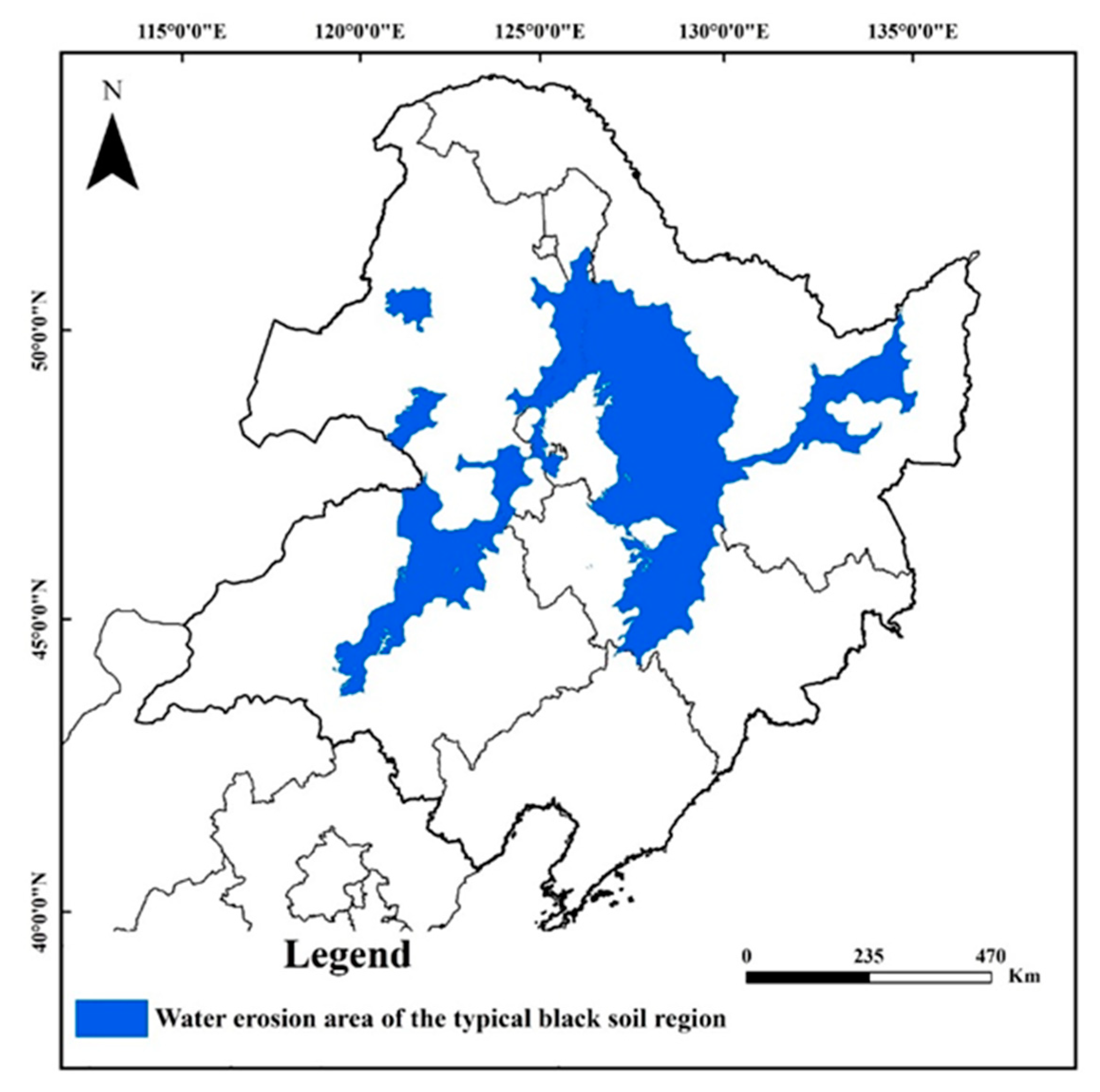
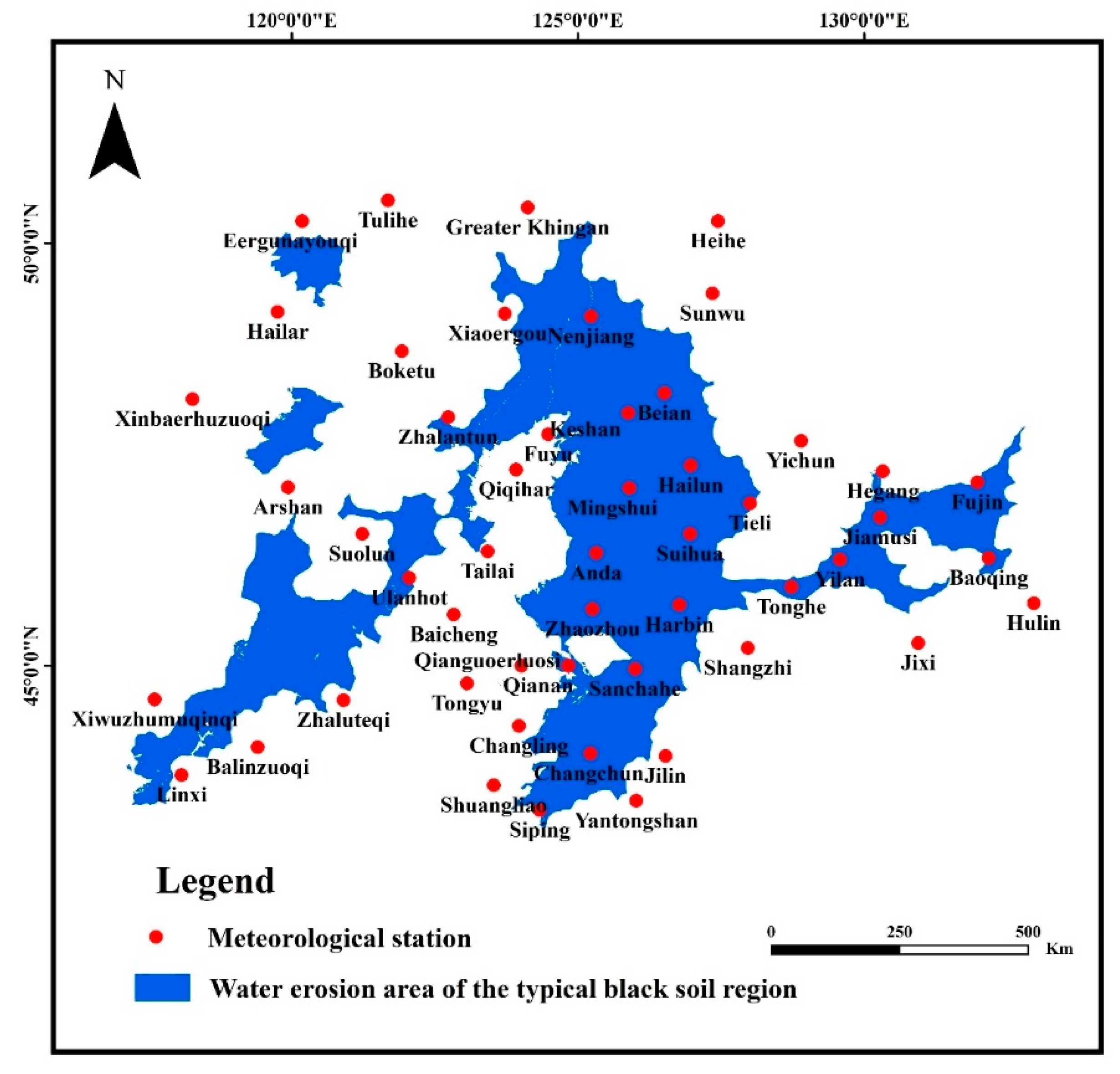
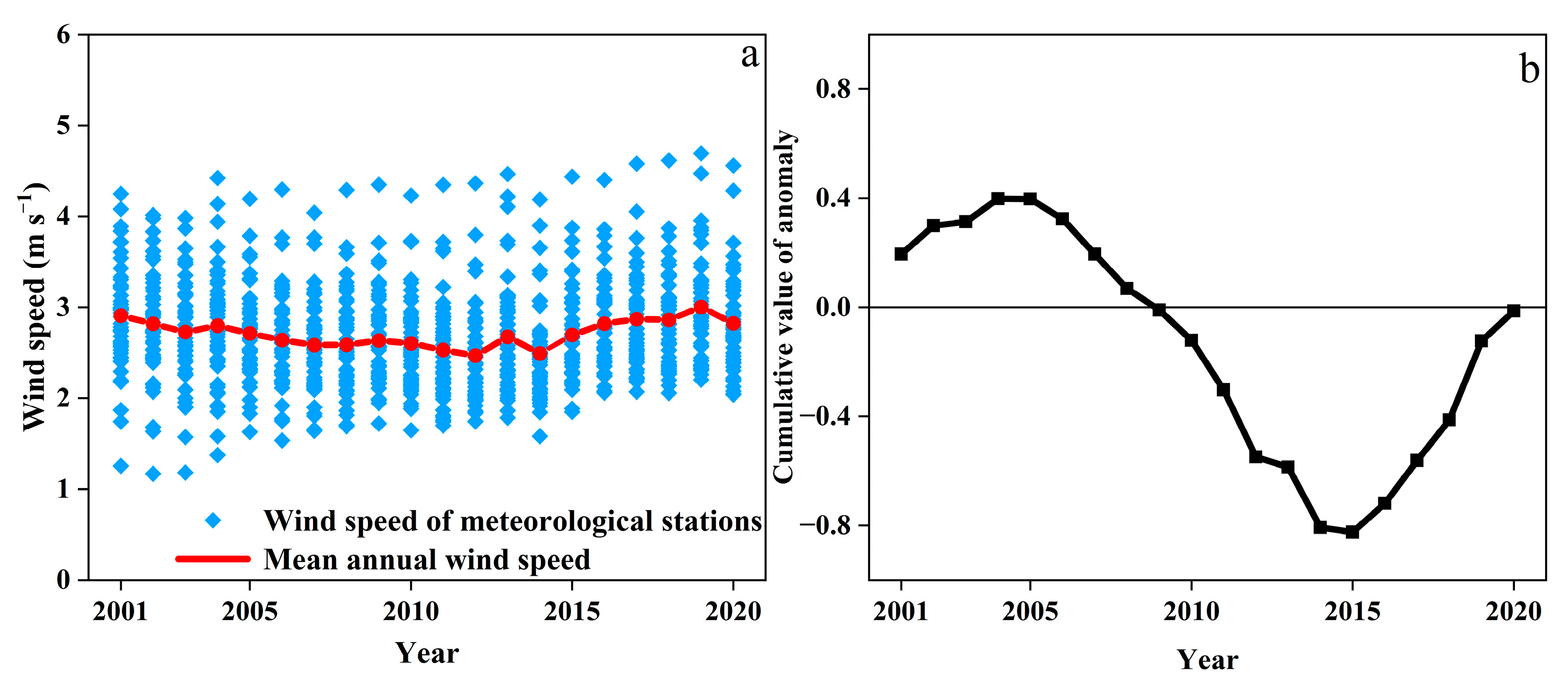

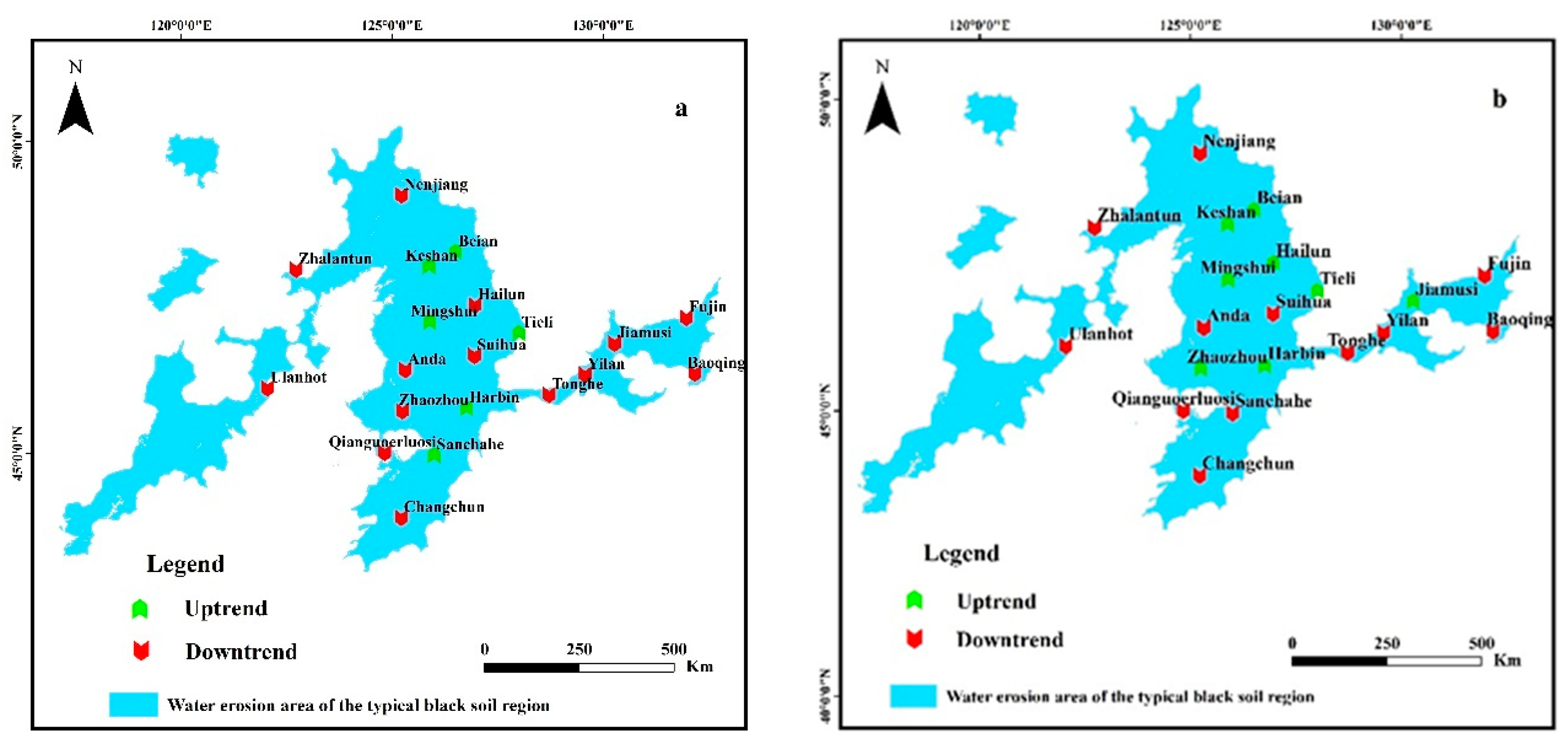
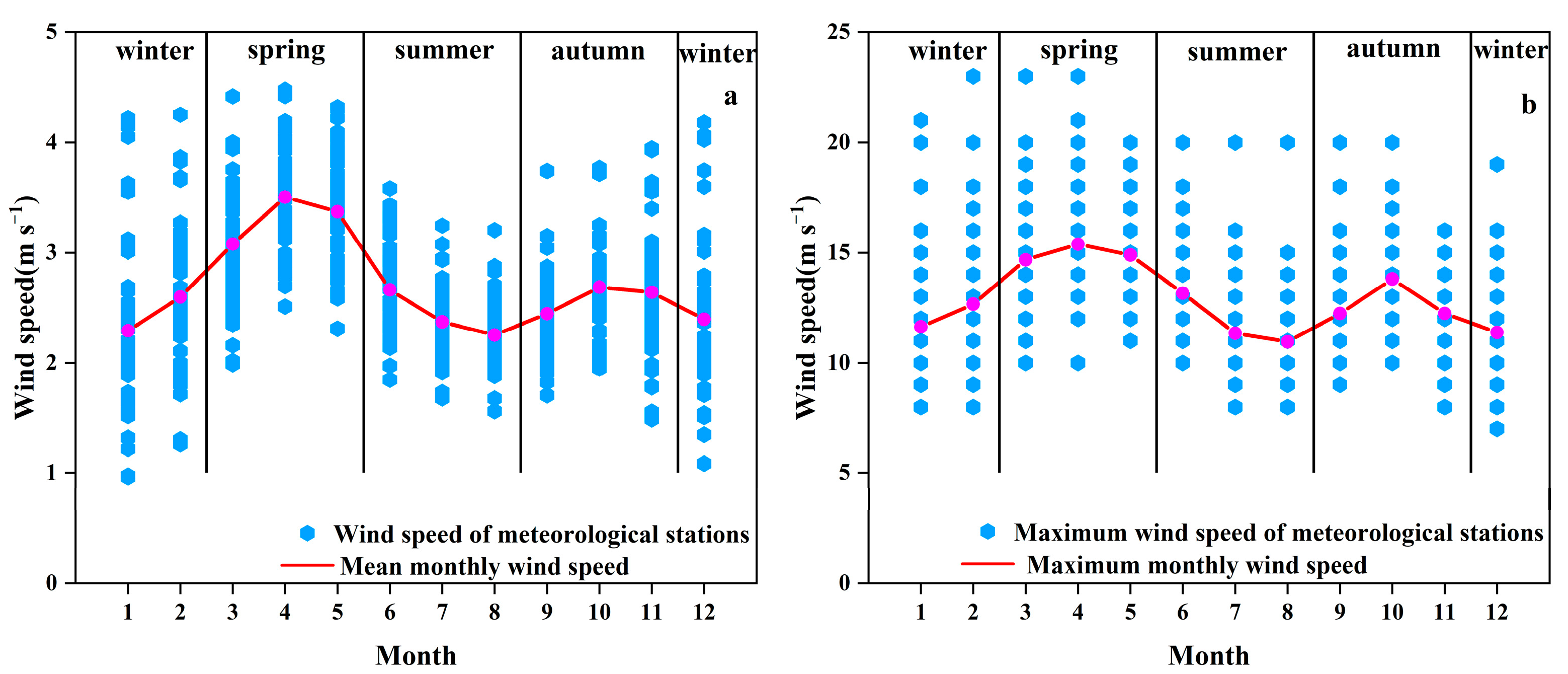


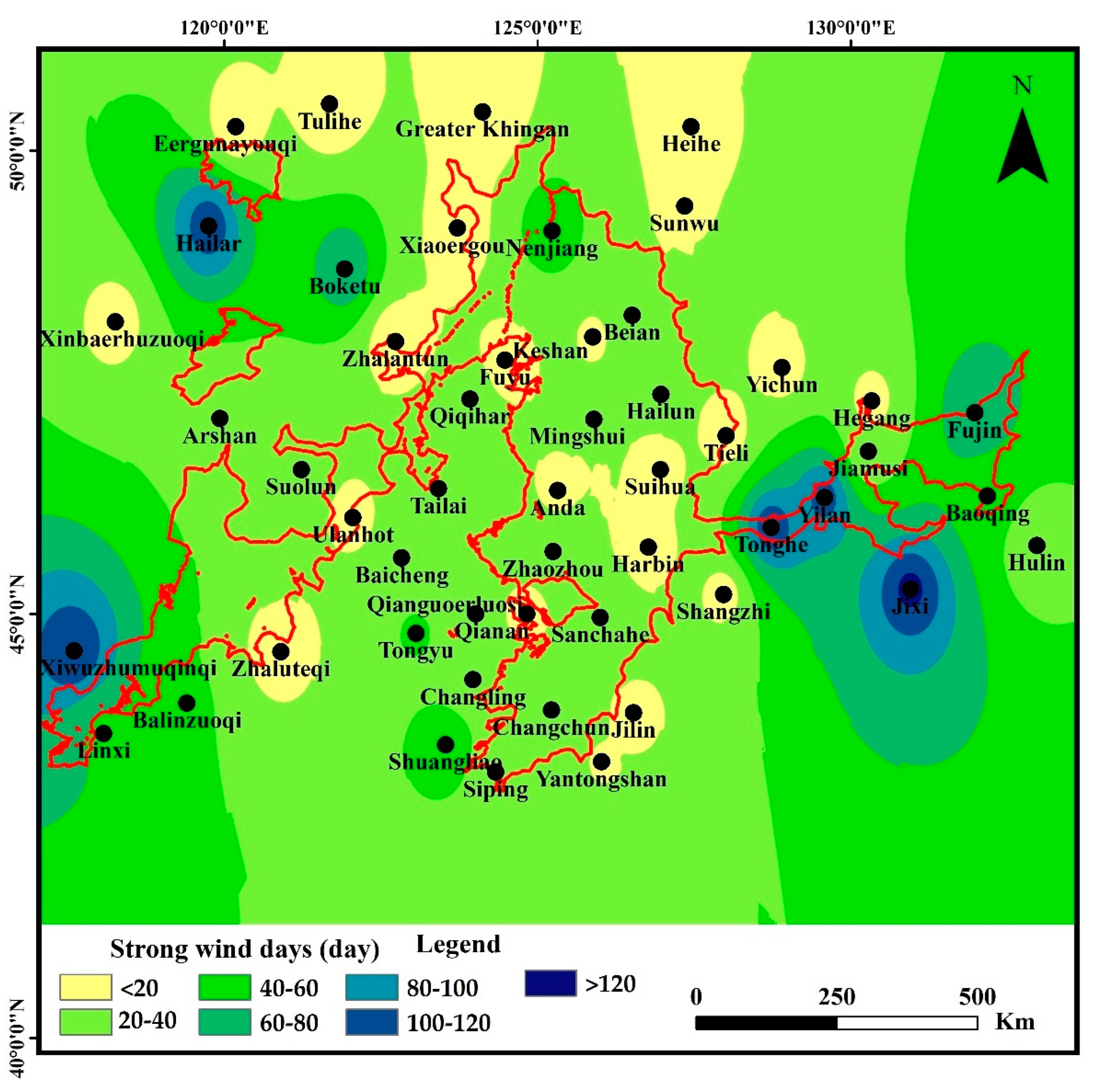

| Classification | Detection Factor | Index |
|---|---|---|
| Terrain | X1 | Digital Elevation Model (DEM) |
| X2 | Slope | |
| X3 | Slope aspect | |
| Geomorphology | X4 | Geomorphological type (Plain, rolling hills, hill, alluvial terrace) |
| Vegetation | X5 | Normalized Difference Vegetation Index (NDVI) |
| Climate | X6 | Air pressure |
| X7 | Temperature | |
| X8 | Precipitation | |
| Land use | X9 | Land use type (cropland, forest, grassland, shrubland, wetland, water body, artificial surface, bare land, tundra) |
| Values of Different Degrees | Categories of the Impact of Wind Force | |
|---|---|---|
| Maximum Wind Speed | Strong Wind Days | |
| mild | mild | mild |
| mild | moderate | mild |
| mild | severe | moderate |
| mild | extremely severe | severe |
| moderate | mild | moderate |
| moderate | moderate | moderate |
| moderate | severe | moderate |
| moderate | extremely severe | severe |
| severe | mild | moderate |
| severe | moderate | severe |
| severe | severe | severe |
| severe | extremely severe | severe |
| extremely severe | mild | severe |
| extremely severe | moderate | severe |
| extremely severe | severe | extremely severe |
| extremely severe | extremely severe | extremely severe |
| Number | Name | Longitude | Latitude | Changing Trend | |
|---|---|---|---|---|---|
| Mean Annul Wind Speed | Maximum Annual Wind Speed | ||||
| 1 | Nenjiang | 125.23 | 49.17 | downtrend | downtrend |
| 2 | Zhalantun | 122.73 | 48.00 | downtrend | downtrend |
| 3 | Beian | 126.51 | 48.28 | uptrend | uptrend |
| 4 | Keshan | 125.88 | 48.05 | uptrend | uptrend |
| 5 | Hailun | 126.97 | 47.43 | downtrend | uptrend |
| 6 | Mingshui | 125.90 | 47.16 | uptrend | uptrend |
| 7 | Fujin | 131.98 | 47.23 | downtrend | downtrend |
| 8 | Ulanhot | 122.05 | 46.08 | downtrend | downtrend |
| 9 | Suihua | 126.96 | 46.61 | downtrend | downtrend |
| 10 | Anda | 125.32 | 46.38 | downtrend | downtrend |
| 11 | Tieli | 128.01 | 46.98 | uptrend | uptrend |
| 12 | Jiamusi | 130.28 | 46.81 | downtrend | uptrend |
| 13 | Yilan | 129.58 | 46.30 | downtrend | downtrend |
| 14 | Baoqing | 132.18 | 46.32 | downtrend | downtrend |
| 15 | Qianguoerluosi | 124.83 | 45.00 | downtrend | downtrend |
| 16 | Zhaozhou | 125.25 | 45.70 | downtrend | uptrend |
| 17 | Harbin | 126.77 | 45.75 | uptrend | uptrend |
| 18 | Tonghe | 128.73 | 45.97 | downtrend | downtrend |
| 19 | Sanchahe | 126.00 | 44.96 | uptrend | downtrend |
| 20 | Changchun | 125.22 | 43.90 | downtrend | downtrend |
| Summarized | Uptrend | 6 | 8 | ||
| Downtrend | 14 | 12 | |||
| Pecentage | Uptrend | 30% | 40% | ||
| Downtrend | 70% | 60% | |||
| Natural Factors | X1 | X2 | X3 | X4 | X5 | X6 | X7 | X8 | X9 |
|---|---|---|---|---|---|---|---|---|---|
| q value (the mean annual wind speed) | 0.085 | 0.054 | 0.008 | 0.009 | 0.012 | 0.031 | 0.176 | 0.110 | 0.007 |
| p-value | 1.000 | 1.000 | 1.000 | 1.000 | 1.000 | 1.000 | 1.000 | 1.000 | 1.000 |
| q value (the maximum annual wind speed) | 0.083 | 0.017 | 0.002 | 0.023 | 0.007 | 0.061 | 0.088 | 0.032 | 0.007 |
| p-value | 0.003 | 1.000 | 1.000 | 1.000 | 1.000 | 0.884 | 0.000 | 0.983 | 1.000 |
Publisher’s Note: MDPI stays neutral with regard to jurisdictional claims in published maps and institutional affiliations. |
© 2022 by the authors. Licensee MDPI, Basel, Switzerland. This article is an open access article distributed under the terms and conditions of the Creative Commons Attribution (CC BY) license (https://creativecommons.org/licenses/by/4.0/).
Share and Cite
Pei, L.; Wang, C.; Sun, L.; Wang, L. Temporal and Spatial Variation (2001–2020) Characteristics of Wind Speed in the Water Erosion Area of the Typical Black Soil Region, Northeast China. Int. J. Environ. Res. Public Health 2022, 19, 10473. https://doi.org/10.3390/ijerph191710473
Pei L, Wang C, Sun L, Wang L. Temporal and Spatial Variation (2001–2020) Characteristics of Wind Speed in the Water Erosion Area of the Typical Black Soil Region, Northeast China. International Journal of Environmental Research and Public Health. 2022; 19(17):10473. https://doi.org/10.3390/ijerph191710473
Chicago/Turabian StylePei, Liang, Chunhui Wang, Liying Sun, and Lili Wang. 2022. "Temporal and Spatial Variation (2001–2020) Characteristics of Wind Speed in the Water Erosion Area of the Typical Black Soil Region, Northeast China" International Journal of Environmental Research and Public Health 19, no. 17: 10473. https://doi.org/10.3390/ijerph191710473
APA StylePei, L., Wang, C., Sun, L., & Wang, L. (2022). Temporal and Spatial Variation (2001–2020) Characteristics of Wind Speed in the Water Erosion Area of the Typical Black Soil Region, Northeast China. International Journal of Environmental Research and Public Health, 19(17), 10473. https://doi.org/10.3390/ijerph191710473









